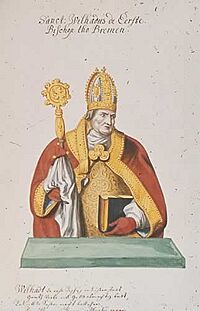Willehad facts for kids
Quick facts for kids Willehad |
|
|---|---|

Willehad of Bremen, from a woodcut of the Late Middle Ages
|
|
| Missionary, Pilgrim and Bishop of Bremen | |
| Born | c. 735 Northumbria, England |
| Died | 8 November 789 Blexen upon Weser, Germany |
| Venerated in | Roman Catholic Church Eastern Orthodox Church |
| Major shrine | Echternach, Luxembourg |
| Feast | 8 November, 13 July (ordination) |
| Attributes | bishop overturning idols |
| Patronage | Saxony |
Willehad (born around 735 AD, died November 8, 789 AD) was an important Christian missionary. He later became the first Bishop of Bremen in 787 AD. He helped spread Christianity in parts of what is now Germany.
Contents
Early Life and Education
Willehad was born in a place called Northumbria, which is in England. He probably went to school in York at St. Peter's School. There, he learned from a wise teacher named Ecgbert. Willehad was also good friends with another famous scholar, Alcuin.
Starting His Mission
Around the year 766, Willehad became a priest. He then traveled to Frisia, a region in what is now the Netherlands. His goal was to continue the work of Boniface, another missionary. Boniface had been killed by the Frisians in 754.
Willehad preached in places like Dokkum and Overijssel. He worked to share Christian teachings with the local people.
Spreading Christianity in Saxony
In 777, a big meeting happened in Paderborn. At this meeting, the region of Saxony was divided into different areas for missionaries. Willehad was given the area between the Weser and Elbe rivers. This area was called Wigmodia.
Challenges and Dangers
From 780, Willehad preached in the lower Weser River area. He was sent there by Charlemagne, a powerful ruler. Willehad faced many dangers. Once, he barely escaped when some Frisians tried to kill him. He had to go back to the area around Utrecht.
Later, he and his helpers were again in danger. Some local people wanted to harm them because they had removed some old temples.
Flight and Return
In 780, Charlemagne sent Willehad to teach the Saxons about Christianity. He worked there for two years. But in 782, the Saxons, led by Widukind, rebelled against Charlemagne. Willehad was forced to run away to Frisia. Sadly, some of his friends and helpers were killed during this time.
Willehad used this chance to travel to Rome. There, he met with Pope Adrian I and told him about his missionary work.
Time at Echternach
After returning from Rome, Willehad spent some time at the Echternach monastery. This monastery is in what is now Luxembourg. He stayed there for two years. During this time, he worked in the scriptorium, a room where books were copied. He also gathered his missionary team again.
Bishop of Bremen
After Charlemagne took control of the Saxons, Willehad went back to preaching. He worked in the areas near the lower Elbe and lower Weser rivers.
In 787, Willehad became a bishop. The area of Saxony and Friesland near the Weser River's mouth became his diocese. A diocese is an area that a bishop is in charge of.
Building the Cathedral
Willehad chose the city of Bremen as his main base. Bremen was first mentioned in official papers in 782. He built a large church there, which became the city's cathedral. Another important person named Anschar later praised its beauty. The cathedral was officially opened in 789. Willehad also built a small church in a place called Blexen.
Death and Legacy
Willehad died in Blexen upon Weser on November 8, 789. Today, Blexen is part of Nordenham. He was buried in the Bremen Cathedral, the very church he had opened just before he passed away.
A writer named Anschar wrote a book about Willehad's life. The introduction to this book was considered a great piece of writing for that time. In 860, a sick girl from a village called Wege traveled to Willehad's grave. People said she was cured by a miracle there. This event was the first time the small village of Wege was mentioned in history.
See also
- Saint Willehad, patron saint archive

